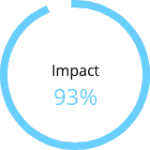What get's measured, gets managed
-Peter Drucker
NVTSI has found the following metrics as keys to accomplishing the goal of increasing the Career Decision Self-Efficacy of veterans, a known indicator for resiliency and success.
To ensure success for our veterans we measure the process, outcomes, and impact.

Process Evaluation – Process evaluation measures the success of the program with respect to meeting the process objective:
Process objective:
To provide resiliency services to veterans, and to provide REBOOT WorkshopTM training and or skills training to these individuals with a goal of 95 – 97% success.
Process evaluation methods consist of the collection of program and individual participant data through use of intake interviews/forms and individual and program tracking forms. The project utilizes a multi-faceted database to ensure efficient and accurate record keeping.
Process data such as number of participants and other relevant data such as age, sex, ethnicity, MOS/NEC, Rank/Rate geographic area, and identified barriers to employment are be recorded.
 Outcome Evaluation – Outcome evaluation measures the success of the program with respect to meeting outcome objectives and consist of both qualitative and quantitative measures.
Outcome Evaluation – Outcome evaluation measures the success of the program with respect to meeting outcome objectives and consist of both qualitative and quantitative measures.
Outcome objectives:
95% of veterans will demonstrate readiness for employment and/or have identified a career interest and are enrolled in college, vocational training or in an On the Job Training (OJT) program.
95% of veterans will set and achieve personal reintegration goals.
Outcome evaluation methods consists of pre-post testing and successful completion of required assignments and “labs.” Qualitative data is obtained through the use of program and self-assessment surveys.
 Impact Evaluation – Impact evaluation measures the program success with respect to meeting impact objectives.
Impact Evaluation – Impact evaluation measures the program success with respect to meeting impact objectives.
Impact objectives are:
Within 90 days of completion of the workshop and/or skills training a minimum of 90% of veterans will be employed or attending college.
12 months after completing workshop and/or skills training a minimum of 85% of veterans will have sustained employment and reduced their dependency on supplemental support.
The monitoring of job placement and placement wages is a part of the programs follow-up procedures and consist of phone and person-to-person interviews with participants. Information is incorporated into NVTSI’s database and reviewed on a weekly basis. Job retention and income statistics are extrapolated from this information and incorporated into program reports.

